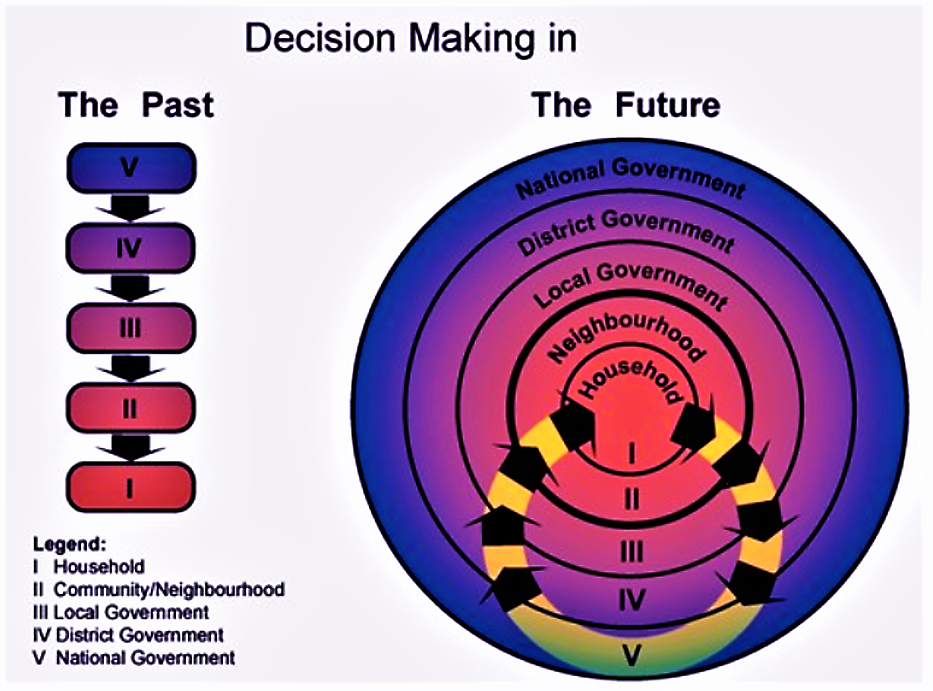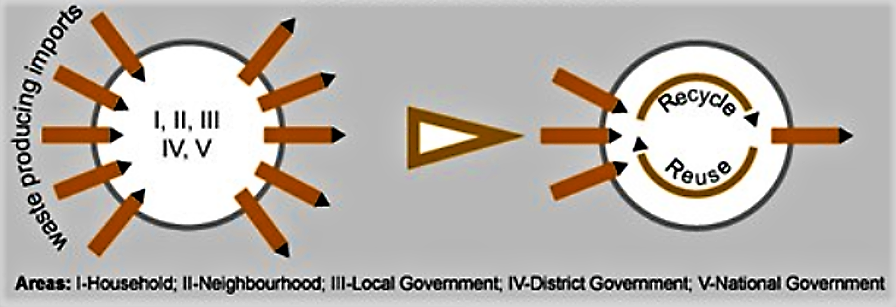The Household-Centred Environmental Sanitation (HCES) approach was conceived by the Environmental Sanitation Working Group of the Water Supply and Sanitation Collaborative Council (WSSCC) and the Swiss Federal Institute of Aquatic Science and Technology (EAWAG) in response to the Bellagio Principles. The HCES approach is a radical departure from past central planning approaches as it places the household and its neighbourhood at the core of the planning process. “The approach responds directly to needs and demands of the users but attempts to avoid problems resulting from purely “bottom-up” or “top-down” approaches” (EAWAG 2005). A Guideline for Decision-Makers was developed to provide first guidance on how to implement HCES, based on a ten-step process that follows a project cycle framework from project identification, pre-planning and preparation, to implementation and monitoring (NETSSAF 2008).
The Household-Centred Environmental Sanitation (HCES) is an integrated multi-sector and multi-actor approach that uses environmental sanitation as an entry point for the planning and provision of key environmental services such as water supply, drainage, sewage systems, on-plot sanitation, solid waste collection, composting and landfill. The HCES represents a new approach for planning environmental sanitation services, with the promise of correcting current unsustainable practices in planning and resource management based on conventional approaches (WERNER et al. 2005). The two main components of HCES are (adapted from SCHERTENLEIB and MOREL 2003):
A radical departure from past central planning approaches, HCES places the stakeholder at the core of the planning process. Therefore, the approach responds directly to the needs and demands of the users, rather than central planner’s often ill-informed opinions about them. It is based on the following principles (see also stakeholder analysis starting by stakeholder identification factsheet):
- Stakeholders are members of a “zone”, and act as members of that zone (“zones” range from households to the nation). Participation is in accordance with the manner in which those zones are organised (for example, communities and neighbourhoods are made up of households; towns are made up of communities, etc.).
- Zones may be defined by political boundaries (i.e. city wards and towns) or reflect common interests (i.e. watersheds or river basins). See also definition of boundaries.
- Decisions are reached through consultation with all stakeholders affected by the decision, in accordance with the methods selected by the zone in question (such as votes at national level in a democratic system or town hall meetings at local level). See also decision making.
- Problems should be solved as close to their source as possible. Only if the affected zone is unable to solve the problem should the problem be “exported”, that is, referred to the zone at the next level.
- Decisions, and the responsibility for implementing them, flow from the household to the community to the city and finally to the central government. See also decision making.

An important principle of the HCES approach is to minimise waste transfer across circle boundaries by minimising waste-generating inputs and maximum recycling/reuse activities in each circle. In contrast to the current linear system, the Circular System of Resource Management (CSRM) emphasises conservation (reducing imports) of resources, and the recycling and reuse (see the various factsheets on this category) of resources used (minimising exports). Resources in the case of environmental sanitation are water, goods used by households, commerce and industry, and rainwater. The circular system practises what economists preach: waste is a misplaced resource. By applying this concept, the circular system reduces “downstream” pollution.

The HCES basically uses a 10-step approach for the development and implementation of an HCES programme. Although the steps are presented in sequence, in practice, they might overlap or might be repeated in order to find acceptable solutions. The 10 steps of the HCES are (NETSSAF 2008):
- Request for assistance: Households themselves or through representatives, request a municipality to assist in improving their environmental sanitation situation. They agree on the scope of work and identify a pilot area. There is a clear picture of who to involve in this (NGO, civil society, CBO or other social intermediary).
- Launch of the planning and consultative process: All stakeholders (see also stakeholder identification factsheet), or their representatives, participate in a meeting or workshops. Together they develop a Memorandum of Understanding and decide which 'local champion' will organise and coordinate activities.
- Assessment of current status: An interdisciplinary team involving the residents of the project area assesses the current status of environmental sanitation. See also: baseline data collection.
- Assessment of user priorities: The outcome of the assessment is discussed and validated with households (men and women), community and other stakeholders.
- Identification of options: Together the groups identify different activities and solutions and explore the implications and requirements. See also the various factsheets on: Planning with the Community (category of the Decision Making section)
- Evaluation of feasible service combinations: A sequence of environmental sanitation service combinations is identified and evaluated on their feasibility. See also decision making.
- Consolidated Urban Environmental Sanitation Services (UESS) plans for study area: An agreed HCES plan for the entire study area is developed.
- Finalising of consolidated UESS plans: The relationship to other environmental sanitation activities within the municipalities is gone into, including their nature and areas of conflict.
- Monitoring, (internal) evaluation and feedback: A strategy for monitoring, internal evaluation and feedback is developed. It includes a plan for collecting data, their critical analysis and use of the conclusions of the evaluation to improve the process. See also participatory monitoring and evaluation.
- Implementation: The plans are carried out, monitored and evaluated. See also project implementation.
An “enabling environment” is important for the success of any investment program, but it is especially vital when applying an innovative approach such as HCES. Most of the critical elements (government support, legal framework, financial arrangements, institutional arrangements and required skills) should be identified or become evident during the program development process (MOREL et al. 2003).
Note that in 2010/2011, a new, more user-friendly version of the HCES-approach is being developed. Check www.eawag.ch for updates on this.
The HCES approach has been developed for the benefit of the many millions of people in urban and peri-urban areas in the developing world who are still deprived of the chance to lead healthy and productive life owing to lack of access to improved environmental sanitation.
In pilot scale projects conducted by EAWAG (LUETHI et al. 2009), the criteria for selecting the sites included: proven interest from population and authorities; specific, easily definable neighbourhoods within a larger city; proven community self-organisation; proven institutional support within the region; opportunity for follow-up investment & implementation.
Household-Centred Environmental Sanitation, Implementing the Bellagio Principles in Urban Environmental Sanitation – Provisional Guideline for Decision Makers
This guideline for decision-makers has been developed to provide first guidance on how to implement the Bellagio Principles by applying the HCES approach. Assistance is given to those willing to include and test this new approach in their urban environmental sanitation service programmes. Since practical experience with the HCES approach is lacking, this guideline is neither comprehensive nor final, but will have to be developed further on the basis of extensive field experience. Available in English, French and Spanish.
EAWAG (2005): Household-Centred Environmental Sanitation, Implementing the Bellagio Principles in Urban Environmental Sanitation – Provisional Guideline for Decision Makers. Geneva, Switzerland: Swiss Federal Institute of Aquatic Science and Technology URL [Visita: 17.06.2019]People’s Choice First, A 4-Country Comparative Validation of the HCES Planning Approach for Environmental Sanitation
From 2006 until the end of 2008, the HCES guidelines, and the concept of a participatory top-down/bottom-up planning approach, were tested in seven different urban and peri-urban sites across Africa, Asia and Latin America. Case studies from four of the seven sites are presented and analysed in this publication.
LUETHI, C. MOREL, A. KOHLER, P. TILLEY, E. (2009): People’s Choice First, A 4-Country Comparative Validation of the HCES Planning Approach for Environmental Sanitation. (= NCCR North-South Dialogue, no. 22 ). Bern: NCCR North-South URL [Visita: 18.06.2019]Integrate at the Top, Involve at the Bottom – The Household-Centred Approach to Environmental Sanitation. Paper presented at the IRC Symposium: Sanitation for the Urban Poor Partnerships and Governance
This paper presents initial experience with implementation of the Household-Centred Environmental Sanitation (HCES) approach, jointly developed by the WSSCC and EAWAG-SANDEC. The presentation explores the theoretical foundations, the problems it seeks to address and practical experience with implementing the novel planning approach, presenting two case studies, one each from Tanzania and Laos.
LUETHI, C. MOREL, A. TILLEY, E. (2008): Integrate at the Top, Involve at the Bottom – The Household-Centred Approach to Environmental Sanitation. Paper presented at the IRC Symposium: Sanitation for the Urban Poor Partnerships and Governance. URL [Visita: 18.06.2019]Alternative Environmental Sanitation Concepts for Developing Countries
Existing Participatory Sanitation Planning Tools (PSPTs). From Deliverable D33, D36 & D39
The Household-Centred Environmental Sanitation Approach (HCES)
An Ecosan Source Book for the Preparation and Implementation of Ecological Sanitation Projects
This document presents the GTZ ecosan project steps in more detail. Though the source book is only available in a draft version it contains important information on the project steps.
WERNER, C. PANESAR, A. BRACKEN, P. MANG, H. P. HUBA-MANG, E. GEROLD, A. (2003): An Ecosan Source Book for the Preparation and Implementation of Ecological Sanitation Projects. Eschborn: German Agency for Technical Cooperation (GTZ) GmbH. [Accessed: 05.04.2010] PDFHousehold-Centred Environmental Sanitation, Implementing the Bellagio Principles in Urban Environmental Sanitation – Provisional Guideline for Decision Makers
This guideline for decision-makers has been developed to provide first guidance on how to implement the Bellagio Principles by applying the HCES approach. Assistance is given to those willing to include and test this new approach in their urban environmental sanitation service programmes. Since practical experience with the HCES approach is lacking, this guideline is neither comprehensive nor final, but will have to be developed further on the basis of extensive field experience. Available in English, French and Spanish.
EAWAG (2005): Household-Centred Environmental Sanitation, Implementing the Bellagio Principles in Urban Environmental Sanitation – Provisional Guideline for Decision Makers. Geneva, Switzerland: Swiss Federal Institute of Aquatic Science and Technology URL [Visita: 17.06.2019]Integrate at the Top, Involve at the Bottom – The Household-Centred Approach to Environmental Sanitation. Paper presented at the IRC Symposium: Sanitation for the Urban Poor Partnerships and Governance
This paper presents initial experience with implementation of the Household-Centred Environmental Sanitation (HCES) approach, jointly developed by the WSSCC and EAWAG-SANDEC. The presentation explores the theoretical foundations, the problems it seeks to address and practical experience with implementing the novel planning approach, presenting two case studies, one each from Tanzania and Laos.
LUETHI, C. MOREL, A. TILLEY, E. (2008): Integrate at the Top, Involve at the Bottom – The Household-Centred Approach to Environmental Sanitation. Paper presented at the IRC Symposium: Sanitation for the Urban Poor Partnerships and Governance. URL [Visita: 18.06.2019]People’s Choice First, A 4-Country Comparative Validation of the HCES Planning Approach for Environmental Sanitation
From 2006 until the end of 2008, the HCES guidelines, and the concept of a participatory top-down/bottom-up planning approach, were tested in seven different urban and peri-urban sites across Africa, Asia and Latin America. Case studies from four of the seven sites are presented and analysed in this publication.
LUETHI, C. MOREL, A. KOHLER, P. TILLEY, E. (2009): People’s Choice First, A 4-Country Comparative Validation of the HCES Planning Approach for Environmental Sanitation. (= NCCR North-South Dialogue, no. 22 ). Bern: NCCR North-South URL [Visita: 18.06.2019]HCES Solid waste management system in Bogande, Burkina Faso
This presentation shows how the Household Centred Environmental Sanitation (HCES) approach was tested and implemented to set up a solid waste management system with the participation of the local population in the city of Bogandé in Burkina Faso.
HELVETAS (2010): HCES Solid waste management system in Bogande, Burkina Faso. Presentation for the 106 Aguasan Meeting. Zurich: HELVETASUrban Sanitation systems – building on the Household Centred Environmental Sanitation approach (HCES)
PowerPoint presentation by Roland Schertenleib, former director of the Department of Water and Sanitation in Developing Countries at the Swiss Federal Institute of Aquatic Science and Technology, explaining the concept in detail.
Schertenleib, R, (2008): Urban Sanitation systems – building on the Household Centred Environmental Sanitation approach (HCES) . Duebendorf.: EAWAG/SANDEC URL [Visita: 16.11.2010]Sanitation Systems and Technologies for Developing Countries. Pdf Presentation
http://www.eawag.ch/
This website of SANDEC, the Department of Water and Sanitation in developing Countries at the Siww Federal Institute of Aquatic Science and Technology (EAWAG) provides more infor on the HCES approach. Check this site to find updates on the new HCES approach.


